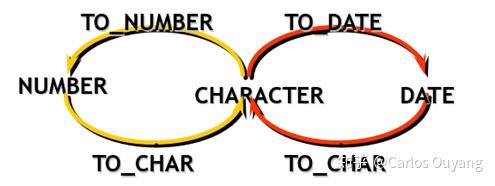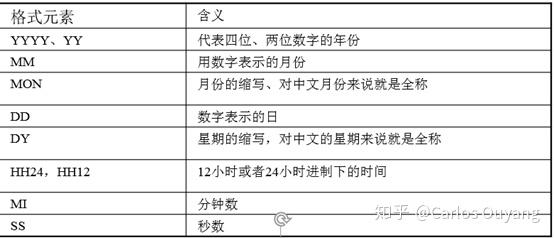函數一般是在數據上執行的,它給數據的轉換和處理提供了方便。只是將取出的數據進行處理,不會改變資料庫中的值。函數根據處理的數據分為單行函數和聚合函數(組函數),組函數又被稱作聚合函數,用於對多行數據進行操作,並返回一個單一的結果,組函數僅可用於選擇列表或查詢的having子句;單行函數對單個數值進行操 ...
函數一般是在數據上執行的,它給數據的轉換和處理提供了方便。只是將取出的數據進行處理,不會改變資料庫中的值。函數根據處理的數據分為單行函數和聚合函數(組函數),組函數又被稱作聚合函數,用於對多行數據進行操作,並返回一個單一的結果,組函數僅可用於選擇列表或查詢的having子句;單行函數對單個數值進行操作,並返回一個值。
dual是一個系統表。註意用於測試。
1 字元相關
1 -- 1.字元串連接 2 select concat('aa','12') from dual; 3 select 'aa'||'12' from dual; 4 5 -- 2.首字母大寫 6 select initcap('abc') from dual; 7 --- 把大寫轉化小寫 8 select lower('ABc') from dual; 9 select upper('abc') from dual; 10 11 -- 把所有員工的姓名小寫輸出 12 select lower(e.ename),e.empno 13 from emp e 14 15 -- 3.填充字元lpad/rpad 16 select lpad('sxt',5,'*') from dual; 17 select rpad('sxt',5,'*') from dual; 18 19 -- 4.去掉空白字元 20 select ' kallen' from dual; 21 select ltrim(' kallen',' ') from dual; 22 select rtrim(' kallen ',' ') from dual; 23 -- trim 刪除左右兩邊的字元 24 select trim('a' from 'abc') from dual; 25 26 -- 5.求子串 substr(str,loc,len)-->loc從1開始 27 select substr('abcd',2,2) from dual; 28 29 -- 6.查找字元串 30 /* 31 如果找到返回>=1的索引;如果沒找到返回0 32 */ 33 select instr('abcd','b') from dual; 34 35 -- 7.求長度 36 select length('abcd') from dual;
2 數值型函數
1 -- 四捨五入round(x,y)對x保留y為小數 2 select round(23.652) from dual; 3 select round(23.652,1) from dual; 4 select round(25.652,-1) from dual; 5 6 -- 返回x按精度y截取後的值 7 select trunc(23.652) from dual; 8 select trunc(23.652,2) from dual; 9 select trunc(23.652,-1) from dual; 10 11 -- mod(x,y)求餘數 12 select mod(9,2) from dual; 13 14 -- ceil 向上取整 15 select ceil(1.9) from dual; 16 -- floor 向下取整 17 select floor(1.9) from dual;
3 日期時間函數
1 -- 返回系統當前時間 2 select sysdate from dual; 3 -- 返回當前會話時區中的當前日期 4 select current_date from dual; 5 6 -- 添加月數 7 select add_months(sysdate,1) from dual; 8 -- 返回兩個時間相差的月數 9 select months_between(sysdate,add_months(sysdate,2)) from dual; 10 11 -- 需求:查詢工作年限在30年以上 12 select e.ename,e.hiredate 13 from emp e 14 where months_between(sysdate,e.hiredate)/12 > 30 15 16 -- 返回date下一月份的最後一天 17 select last_day(add_months(sysdate,1)) from dual; 18 -- next_day(date1,week) 返回date1下周星期幾的日期 19 select sysdate "當時日期",next_day(sysdate,'Monday') "下周星期一" from dual;
日期計算相關
1 --兩個時間進行四則運算的單位是天 2 select sysdate+2 from dual; 3 select sysdate-2 from dual;
4 類型轉換
4.1 隱式類型轉換
1 --字元和數字/日期之間的隱式轉換 2 -- 字元隱式轉換成數值 3 select '100' - 10 from dual; 4 5 -- 字元隱式轉化為日期 6 -- DD-MON-RR 預設的日期格式 7 select 1 from dual 8 where sysdate > '13-May-19';
4.2 顯示類型轉換

4.2.1 to_char()
把日期轉化成字元串,格式元素列表如下

1 -- 把日期轉化成字元 2 -- 按照預設格式DD-MON-RR 3 select to_char(sysdate) from dual; 4 -- 按指定格式 5 select to_char(sysdate,'YYYY"年"MM"月"DD"日" HH24:MI:SS') as t from dual; 6 -- 格式內要打中文(非給定允許的時間分隔符)需要用雙引號引起來
把數值格式化成字元串,控制符如下表

1 -- 把數值格式化成字元串 2 select to_char(12345,'99999.99') from dual; 3 select to_char(12345,'99,999.99') from dual; 4 -- 沒有數的位置補空格 5 select to_char(12345,'999,999.99') from dual; 6 -- 沒有數的位置補0 7 select to_char(12345,'000,000.00') from dual; 8 -- 格式化成美元顯示 9 select to_char(12345,'$000,000.00') from dual;
4.2.2 to_number 、to_date
1 -- to_number 2 select to_number('$12,345','$99,999') from dual; 3 select to_number('$12,345.12','$99,999.99') from dual; 4 5 -- to_date 6 select to_date('14-May-19','DD-MON-RR') from dual; 7 select to_date('2004-09-19','YYYY-MM-DD') from dual; 8 9 -- 查詢雇用期滿6個月的下一個周一的日期。 10 select e.ename,e.hiredate,next_day(add_months(e.hiredate,6),'Monday') 11 from emp e 12 where months_between(sysdate,e.hiredate) > 6
5 decode/case when
decode(條件,值1,“返回值1",值2,“返回值2”,,,“預設值”)
1 -- 需求:查詢員工所在的部門名稱 2 select 3 e.ename, 4 e.deptno, 5 decode(e.deptno,10,'部門1',20,'部門2',30,'部門3','未知') 6 from emp e;
case when - 值匹配
1 select 2 e.ename, 3 e.deptno, 4 case e.deptno 5 when 10 then '部門1' 6 when 20 then '部門2' 7 when 30 then '部門3' 8 else '未知' 9 end 10 from emp e;
case when - 條件匹配
1 -- 需求:根據工資分佈輸出以下信息 2 /* 3 <1000 真屌絲 4 (1001,2000] 屌絲 5 (2001,3000] 白領 6 (3001,5000] 高富帥 7 (5001,10000] 土豪 8 */ 9 10 select 11 e.ename "姓名", 12 e.sal "工資", 13 case 14 when e.sal <= 1000 then '真屌絲' 15 when e.sal <= 2000 then '屌絲' 16 when e.sal <= 3000 then '白領' 17 when e.sal <= 5000 then '高富帥' 18 when e.sal <= 10000 then '土豪' 19 else '未知' 20 end "描述" 21 from emp e;
6 組函數
組函數把多行數據經過運算後返回單個值。也稱聚合函數。

1 -- 求公司雇員的數量 2 select count(*) 3 from emp e; 4 5 select count(e.empno) 6 from emp e; 7 8 select count(1) 9 from emp e; 10 11 -- avg:對多個記錄的某個欄位求平均值 12 -- 需求:求底薪的平均值 13 select avg(e.sal) 14 from emp e; 15 16 -- 需求:求雇員的最高薪資/最低薪資 17 select max(e.sal),min(e.sal),avg(e.sal) 18 from emp e; 19 20 -- 需求:求公司一個月的員工基本開銷 21 select sum(e.sal) 22 from emp e;
- 組函數或聚合函數是對一個數據集(表數據、查詢出來的表、分組的表)進行聚合。(組函數僅可用於選擇列表或查詢的having子句)
- 聚合函數對欄位是 null 的值進行忽略。
- max/min 適合任意數據類型,sum/avg 只適用於數值類型。
聚合函數的結果可以作為其他查詢條件。
1 -- 最早入職的員工 2 select e.ename,e.hiredate 3 from emp e 4 where e.hiredate = (select min(e.hiredate) from emp e);
7 分組
在處理統計或聚合數據時,很多時候需要對數據進行分組。語法
1 select field1,... 2 from tableName 3 group by field1[,field2,…]
按照field1[,field2,…] 分組,欄位值相同的記錄分到一組。
7.1 分組和聚合函數
1 -- 需求:統計部門10的人數 2 select count(1) 3 from emp e 4 where e.deptno = 10; 5 6 -- 需求:求各個部門的平均薪資 7 select e.deptno,avg(e.sal) 8 from emp e 9 group by e.deptno 10 11 -- 需求:求各個部門的月收入平均值 12 select e.deptno,avg(e.sal+nvl(e.comm,0)) 13 from emp e 14 group by e.deptno
7.2 null 值會歸為一組
1 -- 特例:按照津貼分組 2 select e.comm,count(1) 3 from emp e 4 group by e.comm;

7.3 having (重點)
如果需要對分組後的數據進行條件過濾,必須使用having。
1 -- group by having 2 -- 查詢部門平均薪資大於3000的部門 3 select e.deptno 4 from emp e 5 group by e.deptno 6 having avg(e.sal) > 3000 7 8 -- 查詢部門薪資大於3000的雇員按部門分組的平均薪資 9 select e.deptno,avg(e.sal) 10 from emp e 11 where e.sal > 3000 12 group by e.deptno;
- Where過濾行,having過濾分組。
- Having支持所有where操作符。
8 排序 (order by)
當需要對數據集進行排序操作時,語法
1 select field1, field2,... 2 from tablename 3 order by field1,field2
對數據集進行排序,先按 field1 排序,如果 field1 排序相同,按照 field2 排序,以此類推。
- asc 升序,預設
- desc 降序
1 -- order by 2 -- 按雇員薪資排序 3 select e.ename,e.sal 4 from emp e 5 order by e.sal desc 6 7 -- 按薪資升序,名稱降序 8 select e.ename,e.sal 9 from emp e 10 order by e.sal,e.ename desc;
綜合運用
1 --薪資大於1200的雇員的平均薪資大於1500的部門,按照平均薪資升序排序 2 select e.deptno,avg(e.sal) 3 from emp e 4 where e.sal > 1200 5 group by e.deptno 6 having avg(e.sal) > 1500 7 order by avg(e.sal) asc
9 select 語言的執行順序
- 讀取from子句中的基本表、視圖的數據,[執行笛卡爾積操作]。
- 選取滿足where子句中給出的條件表達式的元組
- 按group子句中指定列的值分組,同時提取滿足Having子句中組條件表達式的那些組
- 按select子句中給出的列名或列表達式求值輸出
- Order by子句對輸出的目標表進行排序。
10 多表關聯
10.1 關聯原理
1 -- 笛卡爾積 2 select * 3 from emp,dept

10.2 等值連接
1 -- 等值連接 2 -- 需求:查詢雇員的部門名稱 3 select e.ename,e.deptno,d.dname 4 from emp e,dept d 5 where e.deptno = d.deptno
10.3 不等值連接
1 -- 查詢每個雇員的薪資等級 2 select e.ename,e.sal,sg.grade 3 from emp e,salgrade sg 4 where e.sal >= sg.losal and e.sal <= sg.hisal 5 -- where e.sal between sg.losal and sg.hisal
10.4 外連接
左外連接:左邊的表作為主表,右邊表作為從表,主表數據都顯示,從表數據沒有的位置,用null填充,用 (+) 在 where 中作為尾碼標識主表。
1 -- 需求:查詢所有部門的雇員 2 select * 3 from dept d,emp e 4 where d.deptno = e.deptno(+)
右外連接: 右邊的表作為主表,左邊表作為從表,主表數據都顯示,從表數據沒有的位置,用null填充,用 (+) 在 where 中作為尾碼標識主表。
1 -- 右外連接(B) 2 select * 3 from emp e,dept d 4 where e.deptno(+) = d.deptno;
10.5 自連接
一個表自身連接自身時,稱為自連接。自連接以不同的視角看待同一張表。
1 -- 查詢每個雇員的上級領導 2 select e.ename "雇員",m.ename "領導" 3 from emp e,emp m 4 where e.mgr = m.empno
10.6 多於兩張表的查詢
如果有多個表參與查詢,先把 t1 x t2 笛卡爾積得到一個大表 T1,再把 T1 x t3 笛卡爾積得到一個另外的大表T2,依次類推。所有的多表查詢最終都是兩種表的查詢。



